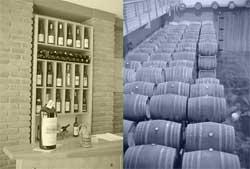Wines with a chilean
passport
 The national wine-producing
sector has been one of the
greatest growing areas of Chilean
exports in the last decade,
becoming the star of Chilean
exports. The national wine-producing
sector has been one of the
greatest growing areas of Chilean
exports in the last decade,
becoming the star of Chilean
exports.
Unfortunately, a scientifically
validated methodology does not
exist that confirms the quality for
each type of wine produced in
Chile, and even when the
production and exportation of
these Chilean wines has increased
enormously, the some wine
shipments have been rejected–especially by Europe- because
it was determined that the certain
characteristic pattern attributed
to their origin has not been
fulfilled.
To prevent that this type of
situation affects sales, and to
assure, maintain, and expand in
already conquered markets,
researchers of the faculties of
Pharmacy, Natural and
Oceanographic Sciences, and
Physics and Mathematical
Sciences, as well as the
Biotechnology Laboratory of the
La Platina Regional Center of
Agricultural Research Institute
(La Platina INIA) joined together,
since 2000, to develop a databank
of the chemical and genetic
markers of Chilean red wines,
which will permit their
differentiation and classification according to their type. With this
information, they hope to
strengthen Chilean
competitiveness in the external
market and make the national
wine-making industry sustainable
overtime.
The research forms part of the
Fondef Project Differentiation of
Chilean red wines in the world
market through the identification
of molecular markers
characteristic with respect to type
and origin, an initiative in which
La Platina INIA, the Miguel Torres
Winery; Concha y Toro Winery;
Requingua Agriculture Society
and the Agriculture Wine
Cooperative of Cauquenes
participate with the Universidad
de Concepción.
Searching for chemical and
genetic identity
Chemical analysis of wine using
high-resolution liquid
chromatography and capillary
electrophoresis, joined with
chimiometric data treatment and
plant verification of the wine type
through the use of DNA genetic
identification will make the
differentiation of red wine
according to type possible in a
short time. The methodology
began with the selection of
reference clones from Cabernet
Sauvignon, Merlot, Pinot Noir,
Carmenère, Syrah and
Tempranillo wines, from which
the DNA was extracted and
analyzed using the microsatellite
technique.
Once the wine type was verified,
the grapes were harvested and
their antocians were identified.
In parallel, they were submitted
to micro-winemaking to obtain
their classical chemical
parameters such as pH, set
acidity and alcohol volatility and
grade. High-resolution liquid
chromatography (HRLC) in the
reverse phase modality permitted
the determination of the antocian,
flavonol, and organic acid levels.
With these studies, which are in
their final stage, a database of
chemical markers will be obtained
that will permit verify wine type.
At the same time, La Platina INIA,
also working on wine-type
identification, has also reached
the differentiation stage at the
variety and clone level. La Platina
INIA is using vegetal molecular
biology technique to study the
wine type and clones of the plant,
based in the identification of
specific alleles established by
methodologies based in the use
of microsatellite markers (PCR)
and AFLP, among others.
Once the databanks are available,
the chemical marker profiles of
the Chilean red wines will be
compared with their European
counterparts to establish the
authenticity parameters of the
national wines destined for the
external market. The results
generated by the project have
been presented in several
meetings of the field, at the
national and international level,
where links of scientific
collaboration have been
established with the Technical
University of Braunschweig en
Germany, generating an active
exchange of specialists.
|

